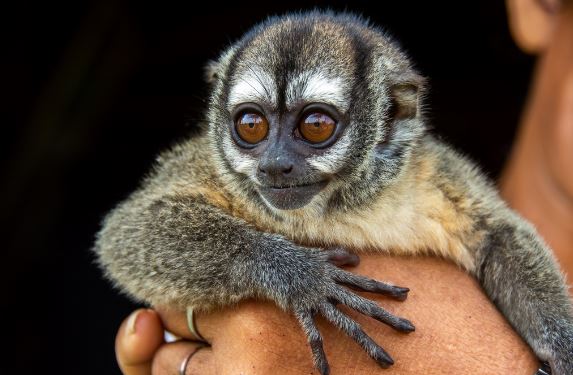Aotus, commonly known as night monkeys or owl monkeys, is a genus of New World monkeys found primarily in Central and South America. These primates are notable for their nocturnal habits and distinctive features that set them apart from other monkey species.
Taxonomy and Classification
1. Genus Overview
The genus Aotus belongs to the family Atelidae and is the only genus within the subfamily Aotinae. It encompasses several species, all of which are adapted to a nocturnal lifestyle. The members of this genus are sometimes also referred to as “owl monkeys” due to their large eyes, which are well adapted to low-light conditions.
2. Species Diversity
Species within the genus Aotus include:
- Aotus azarae: Commonly known as Azara’s night monkey, found in parts of Argentina and Paraguay.
- Aotus nigriceps: Known as the black-capped night monkey, native to the western Amazon Basin.
- Aotus trivirgatus: Also known as the three-striped night monkey, found in the northern Amazon.
Physical Characteristics
1. Appearance
Night monkeys have several distinctive physical traits:
- Large Eyes: Their large eyes are adapted for nocturnal vision, allowing them to see well in low-light conditions.
- Soft Fur: They possess soft, dense fur, which is usually gray, brown, or a combination of these colors.
- Prehensile Tail: Like many New World monkeys, they have a prehensile tail that helps them grasp branches.
2. Size and Build
Adult night monkeys are medium-sized primates. They typically measure around 40 to 60 cm (16 to 24 inches) in body length, with an additional 40 to 50 cm (16 to 20 inches) of tail length. They weigh between 800 grams and 1.5 kg (1.8 to 3.3 lbs).
Behavior and Ecology
1. Nocturnal Lifestyle
Unlike most primates, night monkeys are primarily nocturnal. They are most active during the night and rest in nests or dens during the day. Their nocturnal nature is supported by their large eyes, which enhance their vision in the dark.
2. Diet and Feeding
Night monkeys are primarily frugivorous, meaning their diet consists mainly of fruit. They also eat leaves, insects, and small animals. Their diet can vary depending on the availability of food sources in their habitat.
3. Social Structure
Night monkeys typically live in small family groups consisting of a mated pair and their offspring. They are known for their strong family bonds and often engage in social grooming and vocalizations.
Habitat and Distribution
1. Geographical Range
Species of Aotus are distributed across various parts of Central and South America. They inhabit a range of environments, including tropical rainforests and secondary forests. Their range extends from southern Mexico to parts of Brazil.
2. Habitat Preferences
Night monkeys prefer dense, primary forest habitats but can also be found in secondary forests and areas with abundant vegetation. They are arboreal, spending most of their time in trees where they find food and shelter.
Conservation Status
1. Threats
The primary threats to night monkeys include habitat destruction due to logging and deforestation, as well as illegal pet trade. Some species also face pressure from hunting and environmental changes.
2. Conservation Efforts
Efforts to conserve night monkeys involve habitat protection, anti-poaching measures, and promoting sustainable land-use practices. Conservation programs aim to preserve their natural habitats and reduce human-wildlife conflicts.
Research and Importance
1. Scientific Interest
Night monkeys are of interest to scientists due to their unique adaptations to nocturnal life and their relatively rare status among primates. Research on Aotus contributes to our understanding of primate behavior, evolution, and adaptation.
2. Role in Ecosystem
As frugivores and insectivores, night monkeys play a role in seed dispersal and insect population control, contributing to the health and balance of their forest ecosystems.
The genus Aotus represents a fascinating group of nocturnal primates with unique adaptations for life in the dark. Their physical characteristics, behavior, and ecological roles make them an important subject of study in primatology and conservation. Efforts to protect their habitats and ensure their survival are crucial for maintaining the biodiversity of their native regions.
